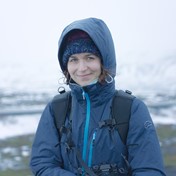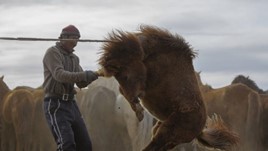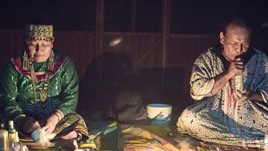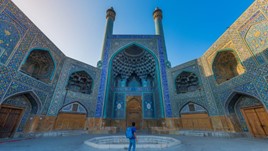
By Maria Sahai
Travel Photographer10 Jul 2018 - 7 Minute Read
“Maria, wake up, we are here.” I hear a voice coming from somewhere close. I recognize our tour guide, a knowledgeable young man who’s been accompanying me and my husband on our journey around Iran for the past few days. I slowly open my eyes and look around. At first, all I see is an uneven gravel road with neat piles of rocks on either side. I feel exhausted – probably because we just finished a four-hour drive in a car with no air conditioning and 45°C (113°F) temperatures outside.

It takes me a few seconds to fully wake up and remember where I am. What I had thought were just piles of rocks are actually entrances to 3,000-year-old, hand-dug caves and the reason we had embarked on this long and hot journey.

We are in Meymand, a remote village in southeast Iran. Visiting it was on the top of my wish list long before we booked this trip. My day job is organizing small group photography tours, which means that I constantly monitor travel blogs and news websites for emerging places to explore. In 2015, while checking a list of recent additions to UNESCO World Heritage sites, I saw an entry describing an ancient village comprised of 350 cave dwellings carved out of a soft rock and inhabited by a few hundred semi-nomadic villagers, all that remained from a much larger community.
The conclusion of the article was rather sad, stating that without external support, this lifestyle was highly vulnerable and could disappear within a generation. Ever since, I knew I had to visit Meymand as soon as possible.

Fast-forward a year, and here we are, greeted by a lady in her 70s who kindly agreed to host us for the night. She turns and begins walking briskly towards the caves. Our guide signals us to follow her. With our bulky backpacks stuffed with photography gear, we can barely keep up with her pace. I try to convince myself that if I had lived my whole life raising animals on mountain pastures in summer and shoveling walls of snow around my cave in winter, I would be as fit.

We leave our belongings in a small, one-room cave that has been transformed by the locals into a hotel room. It has four single beds along the walls, a low ceiling, and several layers of carpets covering the rocky floor. The locals pride themselves on the latter, as for centuries, Meymand carpets have been well-known both in Iran and abroad.
Tourism is the best chance for the villagers, since most of them are too old to lead the traditional semi-nomadic lifestyle. But infrastructure is poor, and in winter, the roads can be blocked by snow for days. The locals hope for UNESCO funding to help improve the infrastructure – if tourism increases, maybe their children will see it as an opportunity and move back.

A hot dinner is waiting for us. Over noodles with vegetables, warm flat bread, and homemade yogurt, we enquire about her family. Her husband passed away years ago and all her kids live in large towns several hours distant. They come once every few weeks to bring her groceries.
Though living on her own can be really tough, she would never consider moving away. Through our guide, she tells us this is where she belongs.


Next morning after breakfast, we pack our belongings and are about to get back on the road. Suddenly, the hostess appears in our cave’s entrance, holding a small plastic bag full of sugar-coated peanuts, a popular tea snack in Iran. With a shy smile, she hands it to us and says something in the local language. We don’t need an interpreter to understand that she wishes us a safe trip.
We smile and nod back, regretting that we didn’t prepare a parting gift for her but also knowing that she doesn’t expect to receive anything in return.
Leaving Meymand, I feel a lot of admiration for the elders who stay loyal to their way of life. And I also feel a little sad, because if nothing changes, this way of life will disappear, and there is no next generation that will say with pride, “This is where I belong.”

Editor's note: We’re all about adventurous, independent, off-the-beaten track travel, but unfortunately most World Nomads travel insurance policies cannot cover travel to or in Iran.
Discover similar stories in
connection
Travel Photographer
Maria is a professional nature photographer. When she's not photographing icebergs in Greenland or capturing erupting volcanoes in Asia, you can find her leading small group photography tours all over the world with her husband.



No Comments